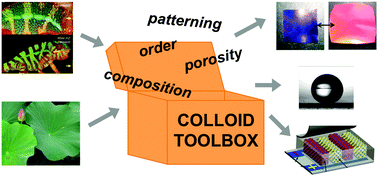A colloidoscope of colloid-based porous materials and their uses
Abstract
Nature evolved a variety of hierarchical structures that produce sophisticated functions. Inspired by these natural materials, colloidal self-assembly provides a convenient way to produce structures from simple building blocks with a variety of complex functions beyond those found in nature. In particular, colloid-based porous materials (CBPM) can be made from a wide variety of materials. The internal structure of CBPM also has several key attributes, namely porosity on a sub-micrometer length scale, interconnectivity of these pores, and a controllable degree of order. The combination of structure and composition allow CBPM to attain properties important for modern applications such as photonic inks, colorimetric sensors, self-cleaning surfaces, water purification systems, or batteries. This review summarizes recent developments in the field of CBPM, including principles for their design, fabrication, and applications, with a particular focus on structural features and materials' properties that enable these applications. We begin with a short introduction to the wide variety of patterns that can be generated by colloidal self-assembly and templating processes. We then discuss different applications of such structures, focusing on optics, wetting, sensing, catalysis, and electrodes. Different fields of applications require different properties, yet the modularity of the assembly process of CBPM provides a high degree of tunability and tailorability in composition and structure. We examine the significance of properties such as structure, composition, and degree of order on the materials' functions and use, as well as trends in and future directions for the development of CBPM.

- This article is part of the themed collection: Bioinspired Surfaces and Materials

 Please wait while we load your content...
Please wait while we load your content...